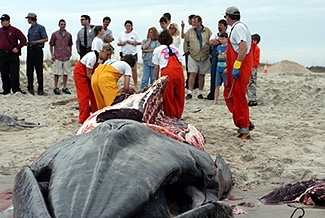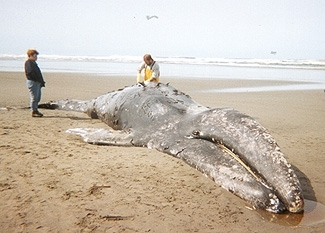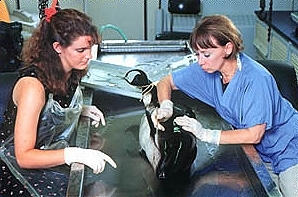 |
| Darlene Ketten |
Darlene Ketten is a senior scientist at the Woods Hole Oceanographic Institution and a researcher at Harvard Medical School. For 20 years, she has studied whales and dolphins that have beached -- or in technical terms “stranded” -- on the Massachusetts coast. She’s featured in Earth & Sky’s radio report on why whales beach themselves. Earth & Sky's Marc Airhart spoke to Ketten in January, 2006
Airhart: I understand that even if a whale or dolphin is alive when it becomes stranded, its chances of survival aren’t high. Why is that?
Ketten: They're really designed to be in the water, to be buoyed up by the water itself. They are not designed to lie with their whole body weight crushing them down against the sand or rocks of the beach.
And also they're designed to be very well insulated so they don't lose body heat in the water. Remember these are mammals. Especially in tropical areas, a whale or dolphin that ends up on the beach is going to be cooking in its own body heat pretty fast.
So what we can do is try to get them back into the water and back off shore. We're not always successful in that. Sometimes an animal will beach live, but it won't be seen in time. If a very large whale, say a 12 or even 18 footer, is left there and rocked about by waves, then they'll get bruised and cut up. Of course sharks can come in, but mostly it's the sheer weight and heat of themselves that will cause them to die.
 |
| Experts conduct a necropsy and collect the whale's skeleton. (NOAA) |
Airhart: That's so tragic.
Ketten: It is. We do have to keep in mind that these are wild animals and they're subject to lots of hazardous conditions, parasites, lots of disease organisms. It's a bacterial soup out there.
And then of course, they're subject to lots of other non-infectious diseases: tumors, kidney failure, aging. We are seeing in animals in captivity where we have good records that even though whales rely on really well designed ears, they get old too. So we do see some animals lose their hearing naturally over time and that's probably going to cut into their survivability too.
Airhart: You sometimes autopsy stranded whales and dolphins that have died. Why?
Ketten: First of all, the term autopsy is used for examining humans. Necropsy is the term we use for examining other animals that are dead.
The most important reason for doing a necropsy on a whale or a dolphin is to learn why they died. Just like we'd do an autopsy on someone who collapsed on the sidewalk. We'd want to know who they are and how they died.
We can help the animals best in the future if we understand the possible range of reasons and what the symptoms were if the animal was observed before it died. Then we can in the future say, well if we see this, this is probably what was wrong with this animal and maybe we can help it and prevent its death.
Another reason is a more fundamental research question and that is just to find out about the animals. These are wonderfully designed creatures for swimming in the water and surviving with extremes of temperatures and pressures. And their sensory systems are adapted for underwater systems. So in a sense, it's the clockmaker's daughter's way of approaching it. If you have the opportunity to observe these unusual creatures, you take the watch apart and hope you can put it back together.
Airhart: When you study animals that have stranded and died, how often can you say what the cause was and how often do you just have to say you don't know?
Ketten: Basically it's about 50-50. Sometimes it's really obvious, something like a ship strike. And sometimes the answers are equivocal: we know this animal was hit by a ship, but we can't tell because of its decay condition if the strike was before or after death. And sometimes we can just see that the animal was basically weak and it had a number of problems wrong with it, a number of diseases, but we don't know which thing really killed it.
These are really big animals. And you often have to do these necropsies, the whale autopsies, under not the best of conditions. You might be in the snow, on the beach, and the tide's coming up and your fingers are getting numb. And you're trying to take apart an animal that’s 20 feet long.
In some cases, we actually have been building forensic style labs where we can bring in smaller animals and work under much better controlled conditions and take much better samples. But everybody who works on these does the best they can under the circumstances.
So somewhere between a third and a half of the time we can give you an answer. That answer can take a while -- sometimes a year or more -- because we have to analyze the tissues pretty carefully.
 |
| Emaciated and stranded gray whale. (NMFS/NOAA) |
Airhart: It sounds like the television show C.S.I.!
Ketten: It is like C.S.I., on a really big and kind of oily scale.
Airhart: How long have you been doing this work?
Ketten: Just about 20 years. I started while I was a graduate student.
Airhart: How do you feel about doing necropsies?
Ketten: Fortunately radio and the internet are not "scratch and sniff," so your listeners won't get the full treatment.
The other fortunate part is that you do kind of get used to it while you're working on any one animal. Mostly it's a good trade off. It's kind of yucky, but on the other hand, it's a fascinating opportunity and an incredible opportunity to see what an animal looks like from the inside out. And also, in some cases, when you can get an answer, to figure out some way to try to help them prevent this in the future.
Airhart: Thank you, Dr. Ketten, for your time.
 |
| Darlene Ketten (right) and student Sarah Marsh prepare to dissect a harbor porpoise. The animal died after being stranded on a Cape Cod beach. (Tom Kleinidnist, ©Woods Hole Oceanographic Institution) |
Airhart: I understand the experts doing the necropsy on the whale that recently swam up the Thames River in London expect to have some results later this week, just a few days after they began. Is that unusual?
Ketten: Well, they'll have some results. You always have some results as soon as you start cutting. What you may not have is definitive results.
Here’s what’s important for the public to remember. You might hear somebody on the beach saying, well, it's this, this and this. But then three or four days later, when everybody starts putting all their information together, and the puzzle pieces start to fall into place, those answers may change. And they may even change several months later when you start getting the lab tests back.
So I would say stay tuned.
Airhart: How is a necropsy done? Do you build special scaffolds?
Ketten: The basic answer is it's done every which way that you can.
First of all, you're talking about moving animals that are often several tons. And of course they are usually not in convenient places. Even smaller animals that might only be tens of kilos are going to be difficult to handle. You try to get them into a sheltered location. In some cases, that means you have to use backhoes, trucks and hoists.
We don't use scaffolding. For the biggest whales, you climb up onto them.
We do often use flensing knives which were designed by the original whalers and are still used for the necropsies to cut into these animals. Essentially we use all ranges of knives, everything from chainsaws or sawzalls down to small scalpels. So on the beach, you'll see a necropsy team with every kind of saw imaginable.
There will be a necropsy team leader who will assign certain people depending on their expertise to different parts of the animal. And because you're trying to do this in an organized and comprehensive manner, you usually have to simply start taking the animal apart in sections. You certainly examine organ systems. So we'll look at the heart, at the kidneys, at the lungs, and so on. But you also have to essentially strip the blubber layer down so that you can see if there are bruises or contusions, or whether you've got some fractures or if you've got subcutaneous bleeding.
You look through the animal to let it tell you everything it can. You should never go into these investigations saying, well I think for instance, it was killed by sonar. You don't go in looking for evidence of sound damage. You go in and you look at every organ system, every tissue objectively.
And that's what I mean by the puzzle pieces coming together. You let the animal tell you what was wrong with it. What may have been wrong with it that it was simply living with? What may have been wrong with it that was extensive and important? What was immediate and what was long term?
Page created on 4/11/2013 5:37:00 PM
Last edited 4/11/2013 5:37:00 PM
